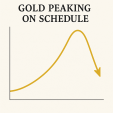Gold is the investment to own as US debt grows out of control - Thorsten Polleit
NEW YORK (May 25) Rising U.S. government debt levels will continue to push more investors toward gold as they seek value and safety in the marketplace, according to one market strategist.
Gold is set to end the week with solid gains, once again holding above $3,300 an ounce. However, Thorsten Polleit, Honorary Professor of Economics at the University of Bayreuth and publisher of the Boom & Bust Report, said he can't rule out a further correction.
He noted that gold remains caught in a tug-of-war between growing fears of an impending recession and a fairly resilient U.S. economy and labor market. Any near-term improvement in the economy or the announcement of new trade deals could push gold prices back down to $3,000 an ounce, he said.
Still, he added that any near-term price dip should be seen as a buying opportunity, as gold's long-term upside potential remains firmly intact. He pointed out that prices are likely to rise as investors begin to lose faith in U.S. Treasuries due to the government’s unsustainable debt levels.
Doubts over the reliability of the U.S. government intensified last week after Moody’s downgraded U.S. sovereign debt to Aa1 from Aaa. At the same time, the agency revised its outlook on the U.S. to "stable" from "negative."
A disappointing 20-year bond auction mid-week also signaled growing investor unease about holding U.S. debt.
These two events underscored gold’s potential for further gains as prices reclaimed lost ground above $3,300 an ounce.
Polleit said the economy is beginning to feel the effects of decades of reckless spending, as rising debt weighs on growth and fuels inflation. He explained that the U.S. now finds itself in a precarious no-win situation.
If the Federal Reserve maintains a neutral monetary policy in response to elevated inflation, rising interest rates could plunge the economy into a deep recession. Conversely, if the Fed cuts rates to lower bond yields, it could stoke inflation, reduce real yields, and lower the opportunity cost of holding gold, which pays no interest.
“We can think about this like watching a circus clown juggling balls,” he said. “He starts with two, then someone throws him another. He manages that, and then another. Maybe he can juggle six balls, but at some point, one will come that he can’t handle—and everything will come crashing down.”
“In this environment, as risks build, gold is an asset investors need to own.”
While ongoing economic uncertainty and persistent inflation remain supportive for gold, Polleit acknowledged that some investors might be hesitant to enter the market with prices at elevated levels.
Still, while generalist investors may be cautious, Polleit said he is closely watching the official sector and expects central banks to continue buying gold in the current environment.
He added that central bank demand is likely to keep a floor under gold around $3,000 an ounce.
Polleit said gold’s current consolidation phase offers investors a chance to evaluate the metal before it potentially rallies again.
“Investment demand has picked up, but it's still below its 2020 peak,” he said. “The narrative in this environment is that gold is trending up, and investors have an opportunity to optimize their portfolios to determine how gold could play a role.”
KitcoNews










